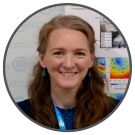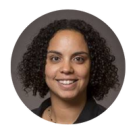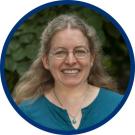The MAC-MAQ Technical Program Committee Committee is comprised of global researchers and educators who have been working in the field for many years. Their goal is to share valuable knowledge and promote continuous improvement in research for years to come. The committee carefully selects and reviews all conference materials to ensure the highest quality, relevance, and scientific accuracy of the information presented.
The 2023 Committee is hard at work planning for the upcoming event. Please say hello to the friendly faces of the TPC!
2023 Lead Chairs

Emma Knowland
NASA, Research Scientist
Dr. Knowland is a lead scientist in the development of NASA GMAO’s atmospheric composition forecast system, GEOS-CF. She directs the transition from research & development to the production system and leads the evaluation of stratospheric composition in the GEOS-CF. Dr. Knowland’s research interests include both chemical and dynamical drivers of stratospheric and tropospheric composition. She is a member of the World Meteorological Organization (WMO) Global Air Quality Forecast and Information System (GAFIS) Steering Committee.

Gabriele Pfister
National Center for Atmospheric Research
Gabriele (Gabi) Pfister received both her master’s degree in geophysics and meteorology (1997) and her doctorate in geophysics (2000) at the Karl-Franzens University in Graz, Austria. After a postdoc at the National Institute of Water and Atmospheric Research in New Zealand, she came to NCAR in 2002 under an Austrian Erwin Schroedinger Fellowship. Pfister’s graduate research focused on shortwave radiative transfer through the atmosphere. Over her career, she has expanded her research to the field of tropospheric chemistry and air quality. She has both developed and used models of global and regional chemical transport, and she has also used satellite retrievals of atmospheric composition and observations from field campaigns to successfully integrate modeling and measurements in her research. Pfister’s work is of direct relevance to society, and she has established strong connections with stakeholders, air quality managers, and policymakers. One of her most notable achievements has been the co-lead of the Front Range Photochemistry Experiment (FRAPPÉ), a major and highly successful field campaign along the Colorado Front Range in July-August 2014 with a focus on studying summertime ozone pollution.

William Vizuete
UNC, Professor
Tackling problems of air pollution mortality and climate change are the global public health issues that motivate Dr. Vizuete's research. In his research, Dr. Vizuete focuses on understanding how the atmosphere can change the formation processes of ozone and PM, and its connection to human health. Through this research, he has increased our scientific knowledge in these areas and produced new insights through air quality models (AQMs), field studies, laboratory experiments and the development of a patented novel in vitro technology.
A better understanding of the atmosphere gives us the knowledge to improve the tools and methods that policymakers use to make effective control strategies to clean the air above our dirtiest cities. What excites Dr. Vizuete most about his research is that he is doing something that makes a real impact on society. Millions of people in the world breathe dangerously polluted air. Through his work, Dr. Vizuete is able to provide scientific advice to policymakers who make decisions that can improve our quality of life.
Additional 2023 Program Committee Members

Maryam Abdi-Oskouei
UCAR, Computational Scientist
Maryam Abdi-Oskouei is a computational scientist with the Joint Center for Satellite Data Assimilation (JCSDA/UCAR). Her current work focuses on the development of the Joint Effort for Data Assimilation Integration (JEDI) framework and emission inversions of trace gasses. Maryam received her PhD from the University of Iowa in 2018. Her thesis focused on using various suites of measurements along with data assimilation techniques to reduce uncertainties in Chemical Transport Models (CTMs) and emission estimates. During this time, she participated in several field campaigns, such as the Lake Michigan Ozone Study (LMOS), ObseRvations of Aerosols above CLouds and their intEractionS (ORACLES), and the Korea US Air Quality Study (KORUS-AQ), as an air quality modeler. Maryam's research interests include air quality modeling across scales, data assimilation, and numerical modeling.

Karin Ardon-Dryer
Texas Tech University, Assistant Professor
Karin Ardon-Dryer is an Assistant Professor in the Department of Geosciences at the Atmospheric Science Group at Texas Tech University. She studies the effect that aerosols (mainly dust particles) have on climate, the environment, and human health. In particular, she takes an interdisciplinary approach and combines field and laboratory measurements to investigate the different meteorological conditions that generate dust events and dust storms and those measured during these events. She focuses on understanding the impact dust events/storms have on air quality and also investigates the effects they will have on human health, using an interdisciplinary single-cell level approach, she developed.

Jeremy Avise
California Air Resources Board, Research Scientist
Dr. Jeremy Avise is Chief of the Modeling and Meteorology Branch at the California Air Resources Board (CARB). Jeremy leads a team of scientists, engineers, and meteorologists who are responsible for conducting regional and local scale modeling in support of State Implementation Plan (SIP) development for ozone and PM2.5, regulatory/rule development, air toxics risk assessments, and CARB’s Community Air Protection Program. In addition, Jeremy’s team oversees the State’s Smoke Management program for agricultural and prescribed burning.

Sebastian Eastham
UCAR, Principal Research Scientist
Dr. Eastham is a Principal Research Scientist in the MIT Joint Program on the Science and Policy of Global Change, and an associate director of MIT’s Laboratory for Aviation and the Environment. His research focuses on the connections between high altitude emissions and long-term, global environmental impacts. This includes improving our understanding of interactions between the climate, air quality and human health, and translating this understanding into both advancing the accuracy of high-fidelity global atmospheric models and developing rapid assessment models which can be made readily available to the public and policymakers alike. The long-term goal of his work is to enable near-real-time integration of observational data into computational models of the environment, supporting unprecedented accuracy and insights with regards to environmental decision-making for impact mitigation and environmental justice.

Louisa Emmons
NCAR, Senior Scientist
Louisa Emmons is a Senior Scientist in the Atmospheric Chemistry Observations and Modeling Laboratory at the National Center for Atmospheric Research (NCAR) in Boulder, Colorado. Her research interests focus on the integration of measurements with models to investigate the impact of sources and their chemical evolution on tropospheric composition. She is part of the team leading the development of MUSICA (MUlti-scale Infrastructure for Chemistry and Aerosols, https://www2.acom.ucar.edu/sections/multi-scale-chemistry-modeling-musica) and has been leading the development of CAM-chem, a component of the Community Earth System Model (CESM).

Heather Holmes
University of Utah, Associate Professor
Heather Holmes is an associate professor in the Department of Chemical Engineering at the University of Utah. Her research focuses on transdisciplinary investigations of processes that govern the transport of atmospheric pollutants. Specifically, her research group uses ground-based sensors, atmospheric models, and satellite remote sensing to investigate atmospheric physics, air pollution sources, and transport and dispersion ultimately to provide data for human health and public policy assessments.

Petra Klein
Oklahoma University, Executive Associate Dean
Dr. Petra Klein is the executive associate dean in the College of Atmospheric and Geographic Science at the University of Oklahoma (OU) and a Regents and Edith Kinney Gaylord Presidential professor in OU’s School of Meteorology. She received a Diploma in Physics and a PhD in Civil Engineering from the University of Karlsruhe in Germany and was a Post-Doc at ETH Zurich in Switzerland. Her research focuses on atmospheric boundary-layer processes and urban climate with applications in air quality and renewable energy.

Carl Malings
NASA, Assistant Research Scientist
Dr. Carl Malings is an Assistant Research Scientist at Morgan State University, working at the NASA Goddard Space Flight Center’s Global Modeling and Assimilation Office through the GESTAR-II cooperative agreement. He currently works to better integrate models with satellite and surface measurements in order to improve air quality estimates and forecasts on intra-urban scales. His educational background is in Civil and Environmental Engineering, and his past research includes advancing the use of low-cost sensors for air quality monitoring in resource-constrained settings.

Susan O'Neill
USFS, Air Quality Scientist
Susan O’Neill is an Air Quality Scientist with the USDA Forest Service Pacific Northwest Research Station. She obtained her Ph.D. from the Laboratory for Atmospheric Research at Washington State University and began her Forest Service career leading the development of a smoke forecasting system for wildland fire that was based upon years of fire and fuels research. She was with the USDA Natural Resources Conservation Service (NRCS) as part of their Air Quality and Atmospheric Change Team for several years, and in 2012 re-joined the Forest Service in wildland fire research. Her research interests include fire emissions calculation; modeling smoke dispersion and transport; and exploring the application of satellite data to smoke and fire.

Brad Pierce
University of Wisconsin-Madison, Director of the Space Science and Engineering Center
Brad Pierce is the Director of the Space Science and Engineering Center (SSEC) and a Professor within the Atmospheric and Oceanic Sciences (AOS) department at the University of Wisconsin-Madison. He is the Principal Investigator of RAQMS (Real-time Air Quality Modeling System). RAQMS is a global meteorological and chemical modeling system for assimilating satellite observations of atmospheric chemical composition and aerosols. He is a member of the NOAA Joint Polar Satellite System (JPSS) Proving Ground, the NASA Tropospheric Emissions: Monitoring Pollution (TEMPO), and NOAA Geostationary Extended Observations (GeoXO) Atmospheric Composition Instrument (ACX) Science Teams.

Daniel Tong
George Mason University, Associate Professor
Daniel Tong is an associate professor and director of Satellite and Earth System Studies Program at George Mason University. Daniel Tong obtained his PhD in Atmospheric Sciences from North Carolina State University and received postdoctoral training at Princeton University. Previously, he served as the Emission Scientist of the US National Air Quality Forecast Capability (NAQFC) program operated by National Oceanic and Atmospheric Administration. Daniel is interested in studying emissions of anthropogenic and natural sources, and their effects on air quality, human health, and climate.

Siyuan Wang
NOAA, Research Scientist
Dr. Siyuan Wang uses a variety of modeling tools and observations (airborne, satelite) to study the chemical and physical processes in the atmosphere, as well as the broad impacts on air quality and the climate system. His current research focuses on the dynamics and chemical evolution of wildfire smoke. He is also interested in the application and integration of novel machine learning techniques in Earth system models.

Yang Zhang
Northeastern University, Professor and Associate Department Chair
Dr. Zhang specializes in atmospheric and environmental research at the interface of Earth system sciences that crosses traditional disciplinary boundaries including energy, air, water, land, ocean, and human health. Over the years, Dr. Zhang has contributed to the development, improvement, application, and evaluation of major 3-D air quality, climate, and Earth system models on urban, regional, and global scales such as STEM III, GChM, MIRAGE, SCICHEM, CMAQ, CMAQ-MADRID, CAMx, MM5, WRF, and mesoscale and global-through-urban WRF/Chem, WRF/Chem-MADRID, WRF-CAM5, WRF/Chem-ROMS, and CESM/CAM5. Her group has also worked on Street-in-Grid models such as SinG, hydrological models such as WaSSI, and health modeling tools such as BenMAP-CE.
Dr. Zhang has devoted sustained efforts to solve some of the most pressing and challenging environment- and energy-related scientific and technical issues related to air and water pollution, acid deposition, global warming and other adverse climate change, as well as associated adverse human health and ecosystem impacts. Dr. Zhang’s research advances the scientific understanding of major atmospheric and environmental issues by developing and utilizing numerical models and analysis tools at various scales (from local to global) to address relevant science and policy questions pertaining to controlling air pollution, mitigating adverse climate change and human health, and minimizing environmental damages in the entire Earth system.
